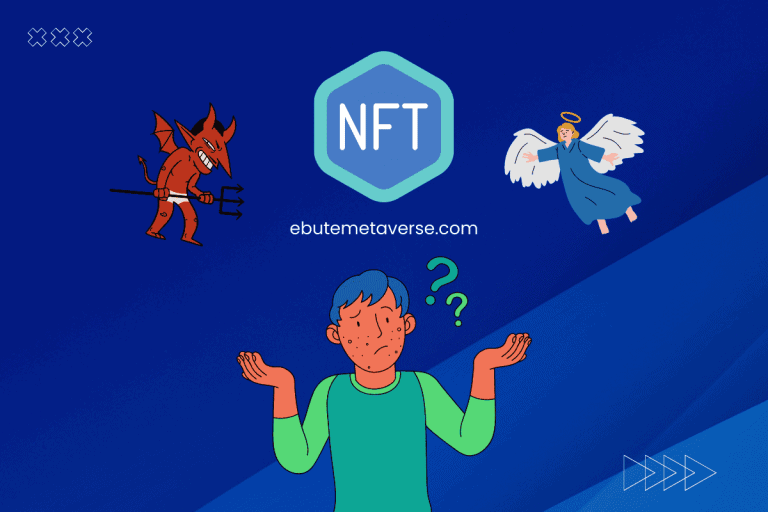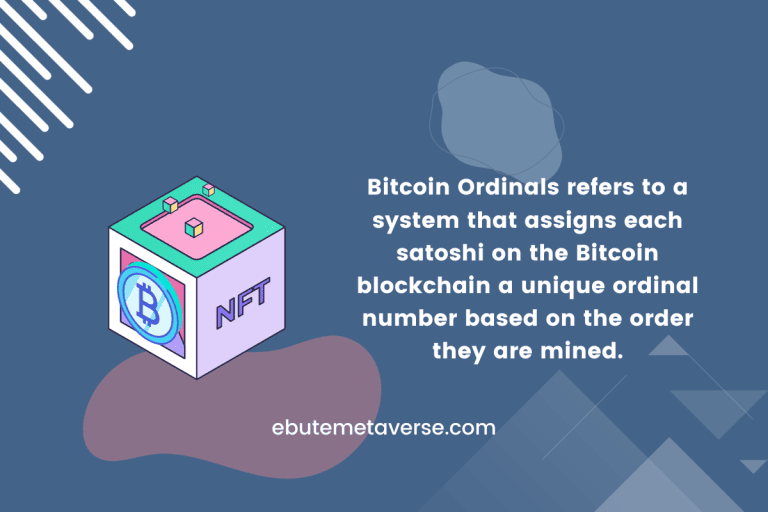Where Are NFT Images Stored? [How To Check It]
Digital arts are gaining a lot of attention. Everyone wants to own an NFT, whether for profit or fun of collecting rare items. But have you asked, “where are NFT images stored?”
NFT images or metadata are usually stored online on central servers (cloud servers) or via a file-sharing service like IPFS. They can also be stored on-chain; however, it’s costly.
It’s easy to believe that NFT images are hosted on the blockchain. But that’s not the case. This article will explain exactly where NFT images are stored and why it’s not on the blockchain.
What’s Contained in An NFT?
One big misconception about NFTs is that it’s a single thing. That’s not true. It’s more of a package that contains two key components: token and metadata.
- NFT Token: First, there’s the token (ERC721 token) — which includes the smart contract that links to the metadata.
- NFT Metadata: The metadata is the underlying media file of the NFT—in this case, the NFT image and other important information.
How will this answer our question? Let’s find out.
Where Exactly are NFT Images Stored?
There are currently three different places creators and projects store NFT metadata:
On-chain Alongside the NFT Token
The metadata of an NFT can be stored on the identical blockchain as the token. This method is the most secure way to store NFTs images. Also, it ensures immortality. Your artwork would remain intact even if the website hosting the NFT crashes.
The first problem with on-chain NFTs is the cost of gas fees if it’s on a Proof-of-Work NFT blockchain. Alternatively, you can keep the NFT metadata on Ethereum layer two solutions like Arbitrum or Polygon to reduce gas fees.
The second problem is the file size, which is usually too big to save on the blockchain. Saving large files on the blockchain takes up much storage capacity.
Examples of on-chain NFT collections include
- CryptoPunks
- Nouns
- Loot
- Autoglyphs.
On Decentralized Storage Servers
Due to the high cost of storing NFTs on proof-of-work blockchains like Ethereum, NFT creators usually opt for cheaper alternatives to store NFT images. For example, by using a decentralized file-sharing service (such as IPFS, Arweave, Filecoin, etc.). This method is known as off-chain storage.
However, using off-chain storage to host NFT images isn’t as secure as the on-chain storage option. You can still lose your assets if your decentralized storage services stop working or shut down.
Using a Private or Centralized Server
This method is the most common option NFT creators, and marketplaces use to store NFT metadata. Here, NFT metadata is stored centrally on cloud servers such as iCloud or Google Cloud.
However, this approach has some built-in disadvantages, all of which are related to centralization. Issues like the company going down, the server crashing, or censorship can prevent you from accessing your files. Whenever you try to view your NFT metadata, a broken link might be displayed instead of your media assets.
How to Know Where Your NFT Image is Stored
You can check where your NFT image is stored using two methods. One is by using a tool called CheckMyNFT, and the other option is by interacting with the blockchain directly.
Using CheckMyNFT
For this article, we’ll use one of BitFox’s NFTs – BitFox #6409, as an example. Here’s the link to the asset on OpenSea: BitFox #6409
To check where your NFT image is hosted using CheckMyNFT, visit www.checkmynft.com and then complete the following steps:
- Step 1: Find the specific NFT on OpenSea. You can click the link above to follow the steps.
![Where Are NFT Images Stored? [How To Check It] 2 image](https://ebutemetaverse.com/wp-content/uploads/2022/10/image-1024x446.png)
- Step 2: After you’ve located the NFT, you’ll look for the contract address of the NFT. On OpenSea, you find this information by clicking the “Details” on the bottom side of the dashboard.
- Step 3: Copy the Contract address on this page or click on it to redirect you to the Etherscan page and copy from there. Also, copy the token ID.
![Where Are NFT Images Stored? [How To Check It] 3 image 1](https://ebutemetaverse.com/wp-content/uploads/2022/10/image-1-1024x665.png)
- Step 4: Paste both information into the “NFT contract address” and “token ID” boxes on checkmynft.com.
- Step 5: Once you’re done, you can click the purple check button to complete the process. This will generate an assessment report about the NFT, including where your NFT image is stored.
Check the NFTs Smart Contract.
You can also check where your NFT image is stored using the smart contract. Here, we’ll be using an NFT from GoblinTown Collection (goblintown #2497) as an example.
![Where Are NFT Images Stored? [How To Check It] 4 goblintown nft art](https://ebutemetaverse.com/wp-content/uploads/2022/10/goblintown-nft-art-1024x661.png)
- Step 1: Find the specific NFT image on OpenSea and look for the contract address. You’ll find this information by clicking the “Details” on the bottom side of the dashboard.
![Where Are NFT Images Stored? [How To Check It] 5 image 3](https://ebutemetaverse.com/wp-content/uploads/2022/10/image-3.png)
- Step 2: Copy the number next to the Token ID (In this case, 2497) and click on the Contract address section. You’ll be redirected to the Etherscan page containing all the NFT info.
- Step 3: Now, on Etherscan, scroll down and locate the “Contract” tab. Click on it and select “Read Contract.”
![Where Are NFT Images Stored? [How To Check It] 6 image 4](https://ebutemetaverse.com/wp-content/uploads/2022/10/image-4-1024x648.png)
- Step 4: Look for a section in this contract called “URI” or “tokenURI” and click it. You should see a box that you can write in. Paste the Token ID number you copied earlier. Click “Query.”
![Where Are NFT Images Stored? [How To Check It] 7 image 5](https://ebutemetaverse.com/wp-content/uploads/2022/10/image-5-1024x557.png)
- Step 5: Now you’ll see some output like this “string: ipfs://QmdxDAXQZn7LtbTCrfLgYX2YbWHGi2t7UQwqSEpt45YEh2/2497,” but the essential point is the prefix. That’s where the data is stored.
An “ipfs” prefix means your NFT image is hosted on IPFS. The same for other platforms like “niftygateway” and “artblocks.io.”
Where Can Collectors Store Their NFTs?
Digital artists have the responsibility of keeping their NFT safe. However, as soon as the ownership changes, the new owner’s responsibility is to keep the asset safe.
So, where should you keep your NFTs, and how should they secure them? Let’s look at the available options.
Software Wallets
One of the best ways to store your NFT tokens is by using software wallets or “hot wallets.” These software programs are available in desktop and mobile versions where you can keep your NFT and cryptocurrencies.
The major drawback of using this type of wallet is that they are connected to the internet. This means it can be hacked if your private keys fall into the wrong hands.
A popular option we recommend is MetaMask, an Ethereum software wallet. Other alternatives include Trust Wallet and Coinbase Wallet. There are also blockchain-specific wallets such as Temple and Kukai for Tezos NFTs and Phantom and Sollet for Solana NFTs.
Hardware Wallets
This type of wallet is precisely the opposite of a software wallet. A hardware wallet is a real-world object, frequently looking like a USB flash drive.
Hardware wallets can let users store cryptocurrencies and NFTs, just like software wallets can. This type of wallet only manages a wallet’s private keys, totally removing them offline. They also have password protection and carry multi-word seed phrases for additional security.
The most widely used hardware wallets are those made by Ledger. For NFT owners, its Ledger Nano X and Nano S are two excellent hardware wallet solutions to consider.
Bottom Line
![Where Are NFT Images Stored? [How To Check It] 8 where are nft images stored](https://ebutemetaverse.com/wp-content/uploads/2022/10/where-are-nft-images-stored-1024x576.jpg)
This article has offered insights into where NFT images are stored and the pros and cons of each storage technique. However, it’s essential to consider the resting place of the NFT’s metadata based on security.
Saving your NFT image on-chain is the safest and has minimal risk of you losing your precious digital art. On the other hand, it’s cheaper to host your NFT image off-chain. However, you’ll have to decide whether the security of your asset is your top priority.
All the same, ensure you do your research before purchasing any NFT.

![Where Are NFT Images Stored? [How To Check It] 1 where are nft images stored](https://ebutemetaverse.com/wp-content/uploads/2022/10/where-are-nft-images-stored.jpg)





